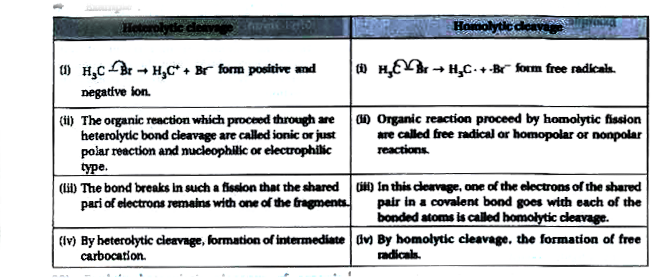What is Fission of a covalent bond? Explain its type with example and main difference
Text Solution
The fission of a covalent bond means the reaction of breaking the covalent bond.
The covalent bond can get cleaved either by: (i) heterolytic cleavage OR (ii) homolytic cleavage

|
Updated on:21/07/2023
Topper's Solved these Questions
- BOOK - KUMAR PRAKASHANCHAPTER - ORGANIC CHEMISTRY SOME BASIC PRINCIPLES AND TECHNIQUESEXERCISE - Section A (Fundamental Concepts in Organic Reaction Mechanism)40videos
ORGANIC CHEMISTRY SOME BASIC PRINCIPLES AND TECHNIQUES
- BOOK - KUMAR PRAKASHANCHAPTER - ORGANIC CHEMISTRY SOME BASIC PRINCIPLES AND TECHNIQUESEXERCISE - Section -A(Methods of Purification of Organic Compounds)44videos
ORGANIC CHEMISTRY SOME BASIC PRINCIPLES AND TECHNIQUES
- BOOK - KUMAR PRAKASHANCHAPTER - ORGANIC CHEMISTRY SOME BASIC PRINCIPLES AND TECHNIQUESEXERCISE - Section A (Isomerism)12videos
ORGANIC CHEMISTRY SOME BASIC PRINCIPLES AND TECHNIQUES
- BOOK - KUMAR PRAKASHANCHAPTER - HYDROGENEXERCISE - Section-D NCERT Exemplar (Long Answer)8videos
HYDROGEN
- BOOK - KUMAR PRAKASHANCHAPTER - QUESTION ASKED IN JEE -2018EXERCISE - MCQ10videos
QUESTION ASKED IN JEE -2018
Similar Questions
Knowledge Check
- Question 1 - Select One
In Homolytic fission of covalent bond ____ is formed
AcationBanionCionDfree radical - Question 2 - Select One
Homolytic fission of covalent bond takes place when bonded atoms have
Asame electronegativityBdifferent electronegativityCsame atomic sizeDdifferent atomic size - Question 3 - Select One
Heterolytic fission of a covalent bond in organic molecules gives
Afree radicalsBcations and anionsConly cationsDonly anions
Define heterolytic fission of a covalent bond.
View SolutionExplain the term covalent bond with example :
View SolutionExplain the term covalent bond with example .
View SolutionWhat is an ionic bond ? With two suitable examples, explain the diference between an ionic and a covalent bond ?
View SolutionWhat is an ionic bond ? With two suitable examples, explain the diference between an ionic and a covalent bond ?
View Solution

